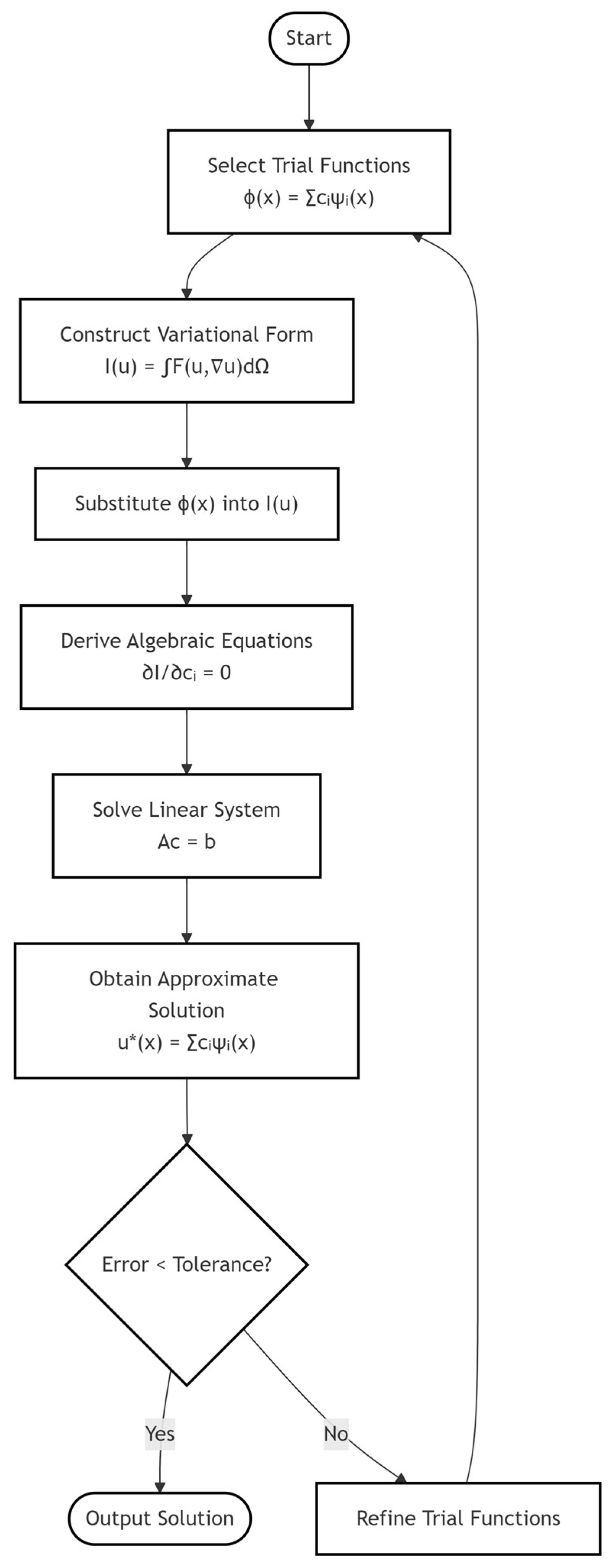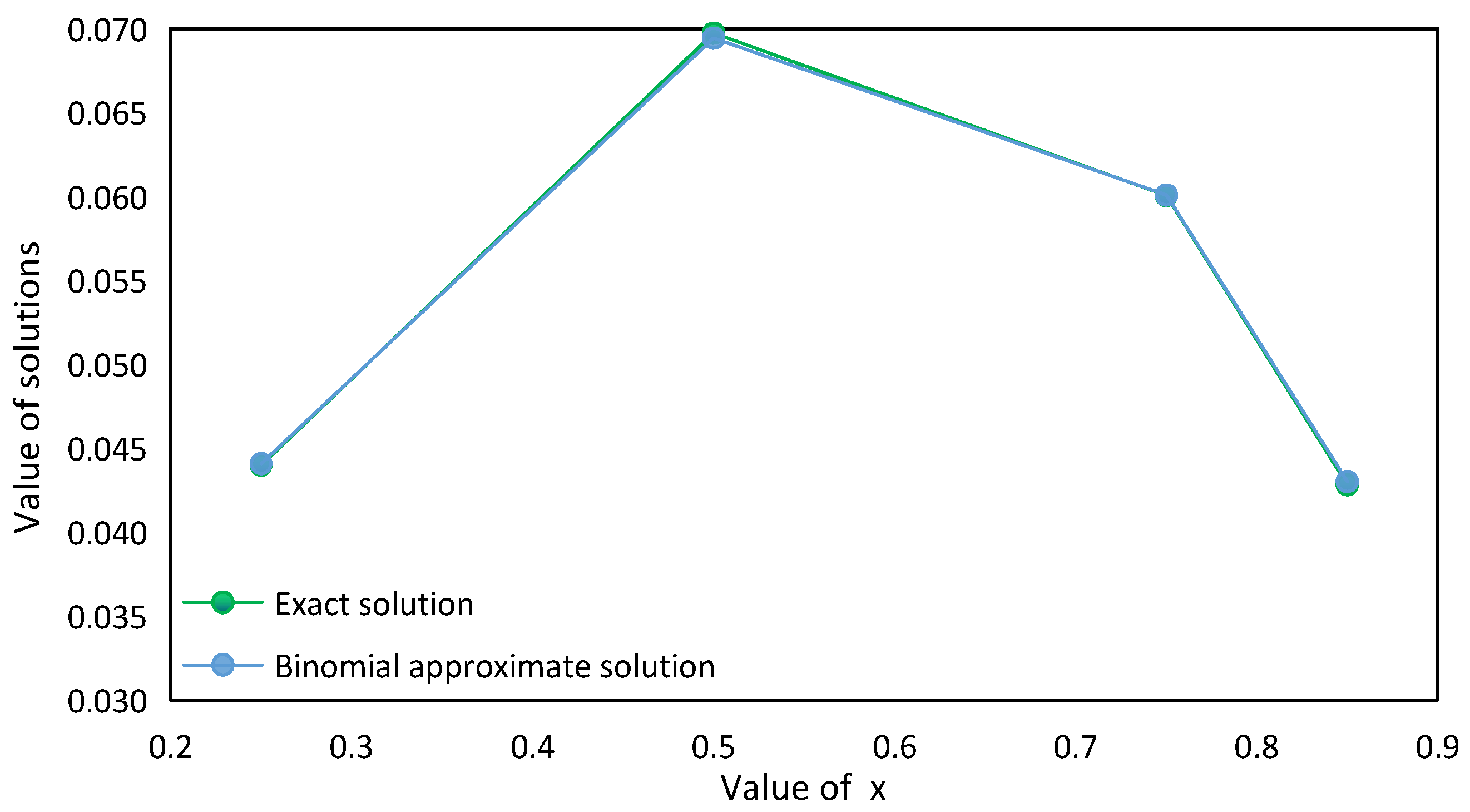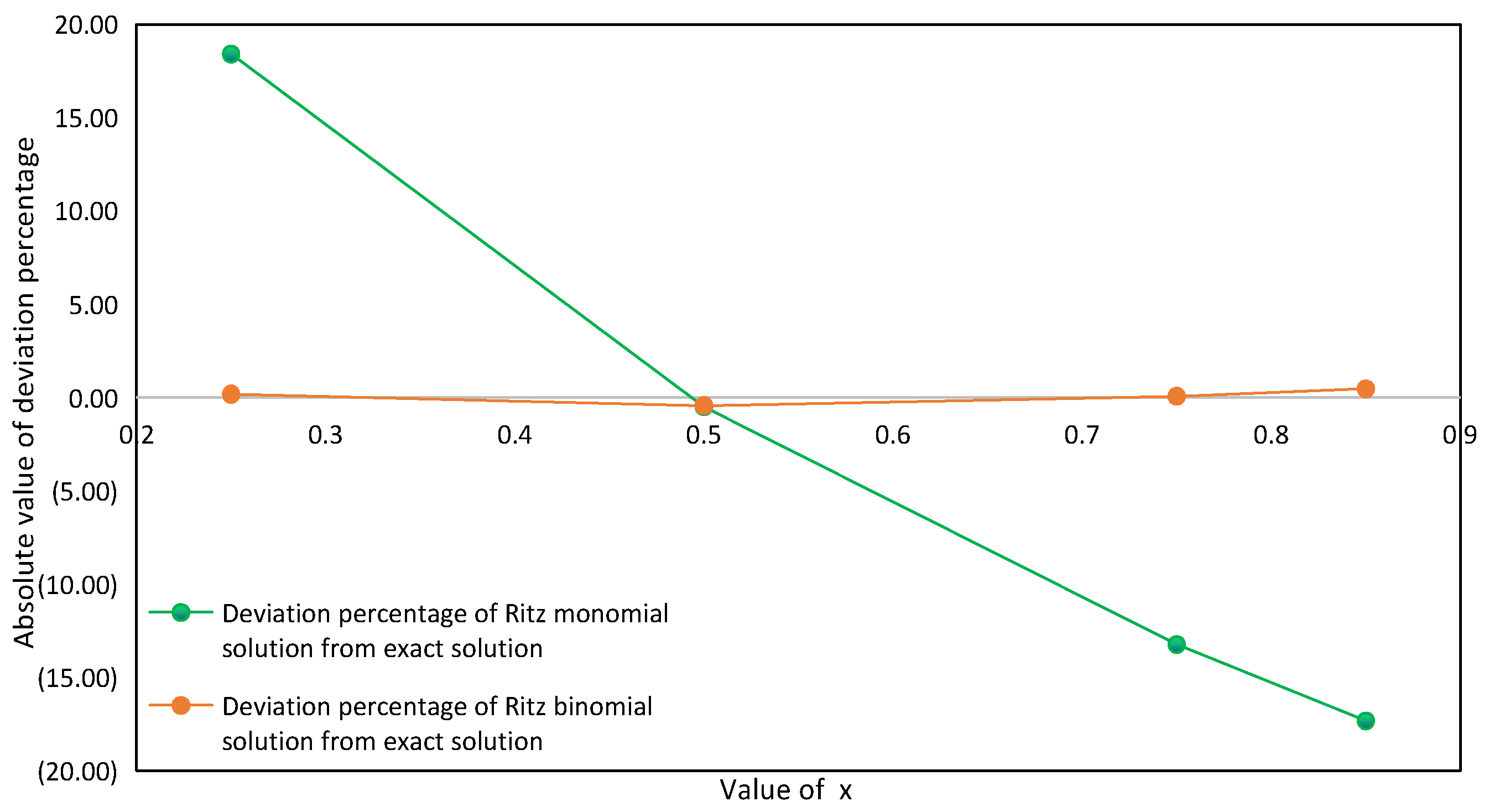Innovative Application of the Ritz Method to Oil-Gas Seepage Problems: A Novel Variational Approach for Solving Underground Flow Equations
Abstract
1. Introduction
2. Theoretical Background of Ritz Method
2.1. Variational Theory
2.2. Corresponding Variational Form of Seepage Problem
3. Solution Procedure of Ritz Method
4. Case Study of Solving Seepage Problem by Ritz Method
4.1. Potential Implementation Scenarios
4.1.1. Classic Darcy Flow (Linear Flow)
4.1.2. Nonlinear Flow in Low-Permeability Reservoirs (Threshold Pressure Gradient)
4.1.3. Matrix–Fracture Coupled Flow (Dual-Porosity Medium)
4.1.4. Gravity-Driven Seepage Flow (Dipping Formation)
4.1.5. Chemical Adsorption/Desorption Effects (Unconventional Oil and Gas)
4.2. Focused Analysis: Simplified Flow Scenarios with Constant A and B
4.2.1. Exact Solution
4.2.2. Trial Solution in Monomial Expression
4.2.3. Trial Solution in Binomial Expression
5. Discussion
5.1. Accuracy Analysis: Error Between Approximate and Exact Solutions
5.2. Limitations of Ritz Method
6. Conclusions
- (1)
- The Ritz method, as an integral approach, provides a viable solution for steady-state seepage problems in finite domains.
- (2)
- While the monomial approximate solution captures the general trend of the exact solution, it exhibits notable deviations (average ±15%).
- (3)
- The binomial approximate solution significantly improves accuracy, with deviations averaging only 0.30%, making it a reliable substitute for exact solutions.
- (4)
- The deviation between approximate and exact solutions is independent of the pressure point’s spatial position, underscoring the method’s robustness.
- (5)
- The Ritz method shows key limitations in oil–gas seepage problems: its accuracy heavily depends on trial function selection. For complex boundaries (such as strongly heterogeneous reservoirs) or nonlinear flows (with slippage/stress-sensitivity effect), constructing suitable trial functions becomes challenging. Three-dimensional transient problems will also face the “curse of dimensionality”, drastically reducing calculation efficiency. Current improvement measures can be considered, such as (1) combining with Galerkin’s method for better boundary handling; (2) using spectral methods for pressure field adaptation; and (3) coupling with numerical methods such as finite volume methods.
- (6)
- Although these suggested methods have demonstrated application potential in engineering problems such as multi-scale seepage in shale gas reservoirs and stress-coupled seepage in tight oil reservoirs, achieving an optimal balance between computational accuracy and efficiency remains a subject requiring in-depth research.
Author Contributions
Funding
Data Availability Statement
Acknowledgments
Conflicts of Interest
References
- Zhang, S.; Lv, Q.; Wang, J.; Liu, L.; Yu, C.; Ji, Y.; Wu, Y.; Hu, H.; Tao, D.; Zhang, M.; et al. Research and practice on deep development technology through flow field regulation in reservoirs with medium-high permeability and high water cut in Shengli Oilfield. Pet. Geol. Recovery Effic. 2025, 32, 88–101. [Google Scholar]
- Zhu, W.; Chen, Z.; Shang, X. Multiphysical field coupling in unconventional oil and gas reservoirs. Chin. J. Eng. 2023, 45, 1045–1056. [Google Scholar]
- Zhang, R.; Wang, T.; Wang, F.; Zhu, X.; Wang, Y.; Kou, S.; Wang, J. Time variation flow model of reservoir permeability based on effective cumulative water flux. Pet. Geol. Recovery Effic. 2025, 32, 162–173. [Google Scholar]
- Ning, W.; Xing, X.; Yang, Z.; Chen, R. The study of characteristics of the precipitated water of high water super heavy oil emulsion. Sci. Technol. Eng. 2015, 15, 177–180. [Google Scholar]
- He, D.; Ji, G.; Jiang, W.; Cheng, L.; Meng, D.; Wang, G.; Guo, Z.; Cheng, M.; Han, J. Differential development technological measures for high-water-cut tight sandstone gas reservoirs in western area of Sulige Gas Field. Nat. Gas Ind. 2022, 42, 73–82. [Google Scholar]
- Bao, J.; Li, L.; Ye, J.; Shi, J.; Zhang, J.; Zhu, H.; Jiang, N. Well location intelligent optimization method and its application for infill wells in high water cut complex fault-block oilfields. Acta Pet. Sin. 2017, 38, 444–452, 484. [Google Scholar]
- Sun, Z.; Li, X.; Xu, B.; Xiao, Z.; Zhang, Y.; Miao, Y.; Peng, Z.; Wang, X. Study on novel method of production capacity analysis on low permeability and unsaturated coal bed methane well. Coal Sci. Technol. 2019, 47, 238–243. [Google Scholar]
- Guo, J.; Li, J.; Yang, X.; Yang, J. Grey modeling based on productivity prediction of low permeability wells. Control Decis. 2019, 34, 2498–2504. [Google Scholar]
- Wu, Y. Percolation characteristics of low permeability carbonate heavy oil reservoir: A case study from O oilfield in Syria. Sci. Technol. Eng. 2017, 17, 159–162. [Google Scholar]
- Fu, N.; Tang, H.; Liu, Q. Technologies for fine adjustment in the middle-later development stage of low permeability tight sandstone gas reservoirs. J. Southwest Pet. Univ. (Sci. Technol. Ed.) 2018, 40, 136–145. [Google Scholar]
- Bian, X.; Zhang, S.; Zhang, J.; Wang, D. Well spacing design for low and ultra-low permeability reservoirs developed by hydraulic fracturing. Pet. Explor. Dev. 2015, 42, 646–651. [Google Scholar] [CrossRef]
- Zhao, M.; Fan, X. Optimized numerical simulation of the fracture network in the shale gas. Pet. Geol. Oilfield Dev. Daqing. 2019, 38, 167–174. [Google Scholar]
- Guo, X.; Yang, K.; Yang, Y.; Jia, H. Influence of seepage velocity on shale gas exploration by pore network simulation. J. Southwest Pet. Univ. (Sci. Technol. Ed.) 2019, 41, 19–27. [Google Scholar]
- Jin, X.; Li, G.; Meng, S.; Wang, X.; Liu, C.; Tao, J.; Liu, H. Microscale comprehensive evaluation of continental shale oil recoverability. Pet. Explor. Dev. 2021, 48, 222–232. [Google Scholar] [CrossRef]
- Xu, R.; Guo, T.; Qu, Z.; Chen, M.; Qin, J.; Mou, S.; Chen, H.; Zhang, Y. Numerical simulation of fractured imbibition in a shale oil reservoir based on the discrete fracture model. Chin. J. Eng. 2022, 44, 451–463. [Google Scholar]
- Mao, X.; Hu, G.; Zhang, X.; Zhang, W.; Qin, Y.; Wang, C. Simulation method of oil-water two-phase transient flow in dual-porosity system in tight reservoir. J. Shenzhen Univ. (Sci. Eng.) 2021, 38, 572–578. [Google Scholar] [CrossRef]
- Li, Q.; Wu, J.; Li, Q.; Wang, F.; Cheng, Y. Sediment Instability Caused by Gas Production from Hydrate-Bearing Sediment in Northern South China Sea by Horizontal Wellbore: Sensitivity Analysis. Nat. Resour. Res. 2025, 34, 1667–1699. [Google Scholar]
- Li, Q.; Li, Q.; Wu, J.; Li, X.; Li, H.; Cheng, Y. Wellhead Stability During Development Process of Hydrate Reservoir in the Northern South China Sea: Evolution and Mechanism. Processes 2025, 13, 40. [Google Scholar] [CrossRef]
- Yin, J.; Yang, F.; Wu, M.; Liu, X. Non-Boltzmann porous medium flow movement law based on homotopy perturbation method. Water Resour. Power 2016, 34, 70, 136–138. [Google Scholar]
- Shao, W.; Li, J. An absorbing boundary condition based on the perfectly matched layer technique in discontinuous Galerkin Boltzmann Method. J. Eng. Thermophys. 2019, 40, 767–775. [Google Scholar]
- Zhao, Z. Thermodynamic analysis for the gas production from gas hydrate by heating. China Min. Mag. 2013, 8, 125–128. [Google Scholar]
- Zhang, J.; Li, C.; Zhang, X.; Li, Z. Laplace transform method of discrete data in well test analysis. Nat. Gas Ind. 2004, 24, 100–102. [Google Scholar]
- Liu, H.; Wang, X.; Zhang, F.; Niu, X. Laplace transform finite difference method for well-test problem with one-dimensional seepage flow. Chin. J. Comput. Phys. 2012, 29, 245–249. [Google Scholar]
- Liang, N.; Qi, C. A new dynamic semi-analytical algorithm of structural system—Laplace integral transform method of dynamic analysis of underground structures. Rock Soil Mech. 2010, 31, 198–206. [Google Scholar]
- Zeng, Y.; Wang, B.; Nie, R. The porous flow model of multi-stage fractured horizontal well in linear composite oil reservoirs. Acta Pet. Sin. 2017, 38, 687–695, 720. [Google Scholar]
- Huo, J.; Jia, Y.; Jiang, W. DST slug well test for low velocity non-Darcy flow in dual-permeability reservoirs. Pet. Explor. Dev. 2005, 32, 98–100. [Google Scholar]
- Tang, X.; Hu, W.; Yan, L.; Zheng, J. Modeling of reservoir dynamic performance by TEM method. Geophys. Prospect. Pet. 2004, 43, 192–195. [Google Scholar]
- Meng, X.; Du, Z.; Wang, X.; Bai, Y.; Shao, C. Seepage characteristics and their affecting factors for the fractured horizontal cracks. Pet. Geol. Oilfield Dev. Daqing 2016, 35, 73–77. [Google Scholar]
- Shen, Y. Integral Equation, 3rd ed.; Tsinghua University Press: Beijing, China, 2012. [Google Scholar]
- Shi, Z. Variational Principle and Finite Element Method; National Defense Industry Press: Beijing, China, 2016. [Google Scholar]
- Kong, X. Advanced Flow in Porous Media; Press of China University of Science and Technology: Hefei, China, 2010. [Google Scholar]
- Song, S.; Zhang, G. Theory and Application of Variational Method, 2nd ed.; Science Press: Beijing, China, 2019. [Google Scholar]
- Wu, C. Methods of Mathematical Physics, 4th ed.; Higher Education Press: Beijing, China, 2010. [Google Scholar]
- Lao, D. Fundamentals of the Calculus of Variations, 3rd ed.; National Defense Industry Press: Beijing, China, 2015. [Google Scholar]





| 0.25 | 0.5 | 0.75 | 0.85 | |
|---|---|---|---|---|
| Exact solution | 0.04400 | 0.06974 | 0.06005 | 0.04282 |
| Monomial approximate solution | 0.0521 | 0.0694 | 0.0521 | 0.0354 |
| 0.25 | 0.5 | 0.75 | 0.85 | |
|---|---|---|---|---|
| Monomial approximate solution | 0.0521 | 0.0694 | 0.0521 | 0.0354 |
| Binomial approximate solution | 0.04408 | 0.06944 | 0.06009 | 0.04302 |
| 0.25 | 0.5 | 0.75 | 0.85 | |
|---|---|---|---|---|
| Exact solution | 0.04400 | 0.06974 | 0.06005 | 0.04282 |
| Binomial approximate solution | 0.04408 | 0.06944 | 0.06009 | 0.04302 |
| 0.25 | 0.5 | 0.75 | 0.85 | |
|---|---|---|---|---|
| Deviation percentage of Ritz monomial solution from exact solution (%) | 18.41 | −0.49 | −13.24 | −17.33 |
| Deviation percentage of Ritz binomial solution from exact solution (%) | 0.18 | −0.43 | 0.07 | 0.47 |
Disclaimer/Publisher’s Note: The statements, opinions and data contained in all publications are solely those of the individual author(s) and contributor(s) and not of MDPI and/or the editor(s). MDPI and/or the editor(s) disclaim responsibility for any injury to people or property resulting from any ideas, methods, instructions or products referred to in the content. |
© 2025 by the authors. Licensee MDPI, Basel, Switzerland. This article is an open access article distributed under the terms and conditions of the Creative Commons Attribution (CC BY) license (https://creativecommons.org/licenses/by/4.0/).
Share and Cite
Liu, X.; Yang, H.; Dong, L.; Lei, M.; Han, J.; Kang, H. Innovative Application of the Ritz Method to Oil-Gas Seepage Problems: A Novel Variational Approach for Solving Underground Flow Equations. Energies 2025, 18, 3207. https://doi.org/10.3390/en18123207
Liu X, Yang H, Dong L, Lei M, Han J, Kang H. Innovative Application of the Ritz Method to Oil-Gas Seepage Problems: A Novel Variational Approach for Solving Underground Flow Equations. Energies. 2025; 18(12):3207. https://doi.org/10.3390/en18123207
Chicago/Turabian StyleLiu, Xiongzhi, Hao Yang, Lifei Dong, Ming Lei, Jie Han, and Hao Kang. 2025. "Innovative Application of the Ritz Method to Oil-Gas Seepage Problems: A Novel Variational Approach for Solving Underground Flow Equations" Energies 18, no. 12: 3207. https://doi.org/10.3390/en18123207
APA StyleLiu, X., Yang, H., Dong, L., Lei, M., Han, J., & Kang, H. (2025). Innovative Application of the Ritz Method to Oil-Gas Seepage Problems: A Novel Variational Approach for Solving Underground Flow Equations. Energies, 18(12), 3207. https://doi.org/10.3390/en18123207







